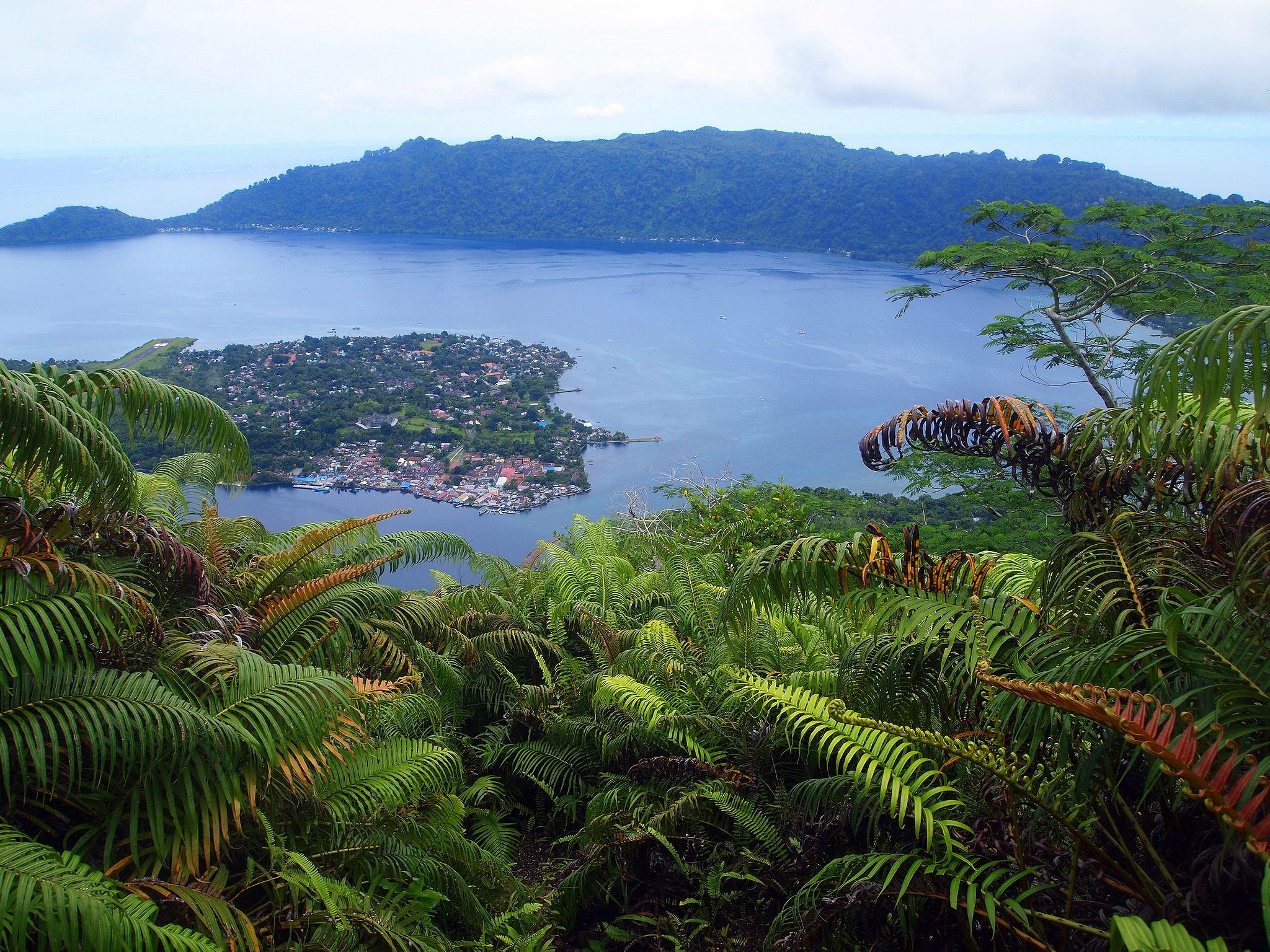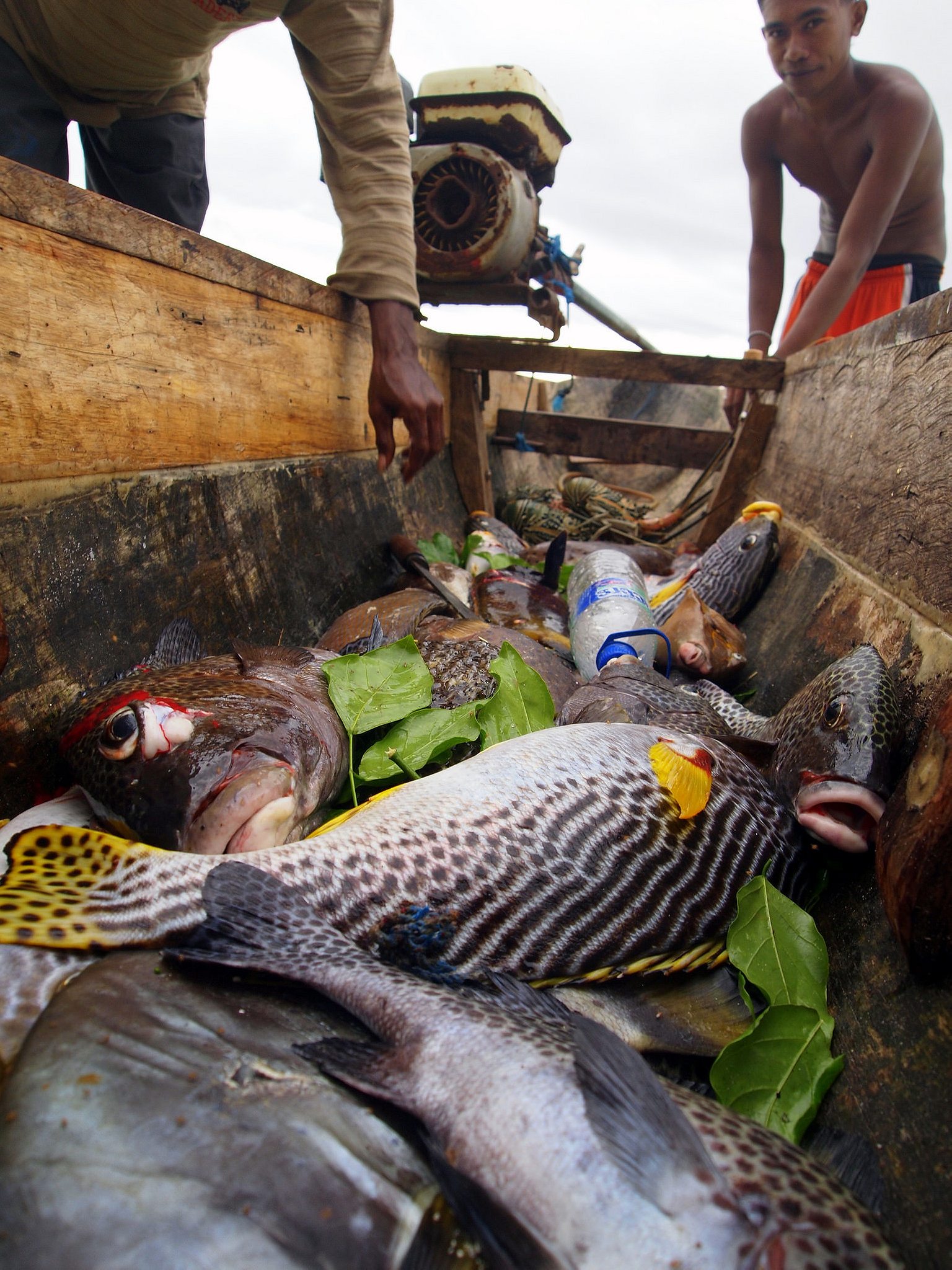A scientist follows the ghost of a forgotten explorer.
Colorful butterflies mix with sulfurous steam clouds at the summit of Gunung Api, an active volcano in Indonesia’s remote Banda Islands. As the volcanic cone drops steeply away, the land gives way to tropical forests. Lizards scurry in the leaf litter and fruit pigeons murmur in the afternoon shadows. Under the forest canopy, spice gardens fringe sandy beaches that plunge into coral reefs where shy sea turtles and colorful reef fish swim.
This is the “other Galapagos,” a living laboratory of evolution called Wallacea. Named after the English naturalist-explorer Alfred Russel Wallace, Wallacea is a region of tropical isles in eastern Indonesia that demonstrates the theory of evolution and serves as a transition zone between the worlds of Asia and Australia.
For eight years, between 1854 and 1862, Wallace’s natural history expeditions took him 14,000 miles around the Malay Archipelago. Visiting every major island at least once, Wallace discovered an invisible species boundary separating the faunas of Asia from Australia, known today as the Wallace Line. Radically different animal groups live on each side of the line; for example, on one side are tigers, on the other are kangaroos, and never the twain shall meet.
Though he didn’t know it, the line he correctly drew separating Bali from Lombok and Borneo from Sulawesi corresponds with a deep-water trench that acted as a barrier to species migration when sea levels were much lower during previous ice ages. Even when Southeast Asia’s islands and isthmuses were connected, deep water separated Wallacea’s islands from one another, shaping distinct biogeographic regions.

The Banda Islands lie right in the heart of Wallacea, rising up over three miles from the depths of the Banda Sea. For several months, I’ve been chasing Wallace’s ghost across the archipelago, revisiting many of the same places he visited so long ago; adventurous naturalists like Wallace inspired me to become a biologist in the first place. I originally set out to find the exotic plants and animals Wallace once described—species like hornbills, orangutans and birds of paradise, to name a few—but over the course of my journey, I find myself focusing on the people I meet as much as the flora and fauna.
Every afternoon in the town of Bandaneira, Abu, an old Bandanese man who befriended me at the market, takes me through the village. Strolling through the colonial-era avenues draped in bougainvillea and drooping fruit trees, he teaches me Indonesian. He smiles and points out objects enthusiastically. Rumah, house. Pohon mangga, mango tree. Burung, bird. He smiles and touches his chest. Teman, friend.
Taking shelter from an afternoon rainstorm one day, Abu invites me to his house to drink kopi manis, sweet coffee, with him and his family. By the time we finish, the rain has stopped. Out we go again, and this time people flood the streets, walking in groups, holding hands. A soccer game breaks out on a muddy field. Always, everywhere, people are together; perhaps that’s why my solo travels seem so strange to the people I meet.
Wallace was also alone on his eight-year journey zigzagging among the islands, traveling by all manner of boat, from mail steamer to merchant schooner to dugout canoe. Onshore, he lived as the local people lived, sheltering in thatched houses and eating whatever could be traded for.
He made stops on Sumatra, Java, Bali, Lombok, Borneo, Sulawesi, and Maluku. In some places, such as Sarawak in Borneo, he lingered for months, netting butterflies and capturing beetles in the nearby forests, shooting birds, or simply processing his specimens and his impressions. He learned enough of the Malay language to do business in remote locales. He hired a Bornean boy named Ali to help with field work and other chores.
When Wallace visited Banda, the islands were an outpost of the Dutch East India Company’s sprawling empire. Certain spices, including nutmeg, were once solely grown on these islands. So valuable were these spices in the 1600s that in almost two centuries of colonial rule, it is calculated that Holland produced a billion guilders from the trade, roughly eight trillion U.S. dollars today. In order to control this lucrative spice trade, the Dutch brutally repressed and attacked the local people, effectively decimating the population while also sowing terror through massacres and forced labor.

Eventually, the Dutch divided the spice-growing territory into plots and handed control to the perkiniers, Dutch planters, whose descendants still grow nutmeg on these ‘spice islands’ today. Meandering through these ancient groves, listening to the booming of the fruit pigeons, it is easy to be transported back in time, before weeds poked through the crumbling ruins of the island’s ancient Dutch fort.
On my last day, Ayu and Chinta, two students from the local school, take me up to the ruins of Fort Belgica, which presides over the harbor. As twilight settles over the island, we listen to the town’s muezzin blare the call to prayer over the tropical bay and looked out over the rampart walls as swallows return to the ruins to nest.
That evening, they treat me to dinner at an auntie’s for bakso, the ubiquitous meatball soup eaten throughout Indonesia. Tomorrow, I’m catching one of the bi-weekly pelni boats that ply the distant extremities of the archipelago, transporting people and goods. They are reluctant to see me go. Before I set off, Chinta and I trade shirts and Ayu makes me promise to find her on Facebook.
In the dim hours of dawn the following morning, the Kelimutu pelni boat arrives in Banda’s tiny harbor on her route further eastward to the Tanimbar and Kai islands. Running to catch it, I am the last one on before the captain hoists the gang walk. The boat is packed shoulder to shoulder, many eying me curiously as the only bule—foreigner—out here.
I wasn’t optimistic for the almost three-day journey ahead on the Kelimutu. When I asked Allen, the village head man about the reputation of this boat, he shook his head and simply said, “Ahhh, the Kelimutu. Worst boat in Indonesia.”

In the hold, the heat feels humid enough to swim through. Sweat drips from my temples. There are no beds or bunks, just two open decks crowded with knee-high linoleum-covered platforms on which people are meant to lie like hot dogs lined up on a grill. The bulkheads are rusty, the ceiling brown, and the deck made of white linoleum covered in ochre cigarette burns. It is an industrial holding pen with the occasional porthole that doesn’t open.
Up on deck, every space is taken up by people or bags of goods. Families sleep on the floor on cardboard box tops. Bags of rice and bunches of bananas sag against the railing, trash overflows from containers, and the men smoke endless clove cigarettes while gazing out to sea. Somehow, I manage to nudge into a small spot on a side deck where I hang up my hammock and get ready for a long sea journey across the empty quarter of the Banda Sea.
Wallace spent eight years perambulating this maritime world by boat. He wrote about underwater earthquakes, phosphorescent blooms of mysterious undersea light, and treacherous riptides that nearly took his life and his boat crew on several occasions.
As Wallace sailed from island to island, he continued collecting specimens to send back to the museums of England. At the midpoint of his travels and specimen collecting, he came to realize how evolution occurred. Bedridden with malaria on the remote island of Halmahera in North Maluku, he thought about why some live and some die, realizing that natural selection determined and pushed forward the evolutionary process. He feverishly wrote down his thoughts and sent the manuscript to Charles Darwin. His letter described how evolution progresses through natural selection. Darwin had also come to the same conclusion and hastened to publish his seminal work, On the Origin of Species. While both men are credited with the discovery, Wallace’s contributions are less remembered, to put it lightly.

On the ship, I meet a group of young men from Java and ask them if they have ever heard of Wallace. They, like most others I’ve met, have never heard of him. But they do have many questions about me: “Where are you from?” “Ahh, American. Obama!” “What is your religion?” “How do you like Indonesia?” “Are you married? No! Do you want a wife?”
They have been on the ship for five days already and are on their way from Java to Papua to try to find work. One of them practices henna on his friend while the rest listen to Indo-pop music, smoke clove cigarettes, and pepper me with questions.
I stumble through my Indonesian while flipping through my pocket dictionary, trying to keep up, a source of endless fascination and amusement. From then on, every time they see me they invite me over for long conversations as we cross through the windless doldrums.
Despite being alone on this ship packed with people, I have friends now. They watch my back and look after me. Like Wallace, I am a stranger, alone, far from home. And like him, I rely on the hospitality and generosity of the people I meet.
As the days roll by, I write, practice my Indonesian with new friends, and search the sea for marine life. One day, I spot dolphins far off the stern, but otherwise the only thing to break the placid waters are flying fish startled by the boat. They appear like magic, radiating outward from the bow like stones skipped from invisible hands.
At dusk, great gray clouds move overhead, and the ship pitches and rolls in darkness, a wood-and-steel speck adrift in Wallacea.